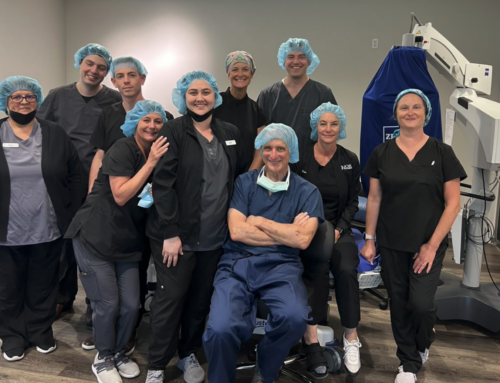
Barth Vision and Optical offers state of the art vision screening for patients. To adequately evaluate eyes and vision our comprehensive examination is focused on obtaining a conclusive diagnosis so that we can prescribe proper treatment. Comprehensive eye examinations are the only effective way to determine if an eye disease or vision problem is present.
Adult Eye Exams
At Barth Vision and Optical the adult eye examination starts with patient and family health history. From there the exam includes:
- Measuring visual acuity
- Tests to determine overall visual function and eye health, including depth perception, color vision, peripheral (side) vision and pupil light response.
- Refractive status assessment to determine the presence of nearsightedness, farsightedness or astigmatism.
- An evaluation of the ability of the eye to focus, eye teaming (how the eyes coordinate vision) and eye movement abilities.
- Eye health examination along with any additional tests that may be needed.
- Periodic eye and vision examinations are an important part of preventive healthcare. Vision and eye problems can occur without the patient even knowing that there is a problem. This is why early diagnosis and treatment of can be a big help in the prevention vision loss.
Patient history
The first step of an eye exam starts with taking a thorough history. This includes details about current eye or vision problems as well as overall health of the patient. If symptoms are present, we will want to know when and how symptoms first began. Letting us know about medications and potential home or work environmental conditions that could affect vision is important. And lastly, we will ask about any previous eye or health conditions the patient’s family members may have experienced.
Visual acuity
Visual acuity measurements evaluate how clearly each eye is seeing. This test can involve reading various types of charts to measure visual acuity both at a distance and close up. Visual acuity test results is presented as a fraction, such as 20/20, 20/40 and so on. The first number is the standard distance at which testing is done (20 feet). The second number is the smallest letter size the patient was able to read on the chart. 20/20 is considered perfect vision.
Initial tests
Initial tests can include evaluations of the patients’ visual depth perception, color vision, eye muscle movements, peripheral or side vision, and the way the pupils respond to light.
Keratometry/topography
Keratometry and topography are tests that measure the curvature of the cornea or the clear outer surface of the eye. This is done by focusing a circle of light on the cornea and measuring its reflection. This test is significant for determining the proper fit for contact lenses.
Refraction
Refraction determines the lens power needed to compensate for any refractive error (nearsightedness, farsightedness, or astigmatism). For this test, an instrument called a phoropter is placed in a series of lenses in front of the patients’ eyes. The doctor then measures how the various lenses focus light using a handheld lighted instrument called a retinoscope. The lens power is then refined based on the patient’s input on the lenses that offer the clearest vision.
Eye focusing, teaming, and movement
To see a clear, single image, the eyes must be able to effectively change focus, move and work in unison. An assessment of accommodation, ocular motility, and binocular vision determines how well the eyes focus and function together. This testing is designed to determine problems that may prevent eyes from focusing effectively or if there is a problem that makes using both eyes together difficult.
Eye health evaluation
A wide range of microscopes, lenses, and digital technology are used to assess the overall health of the eye and the surrounding tissues. Dilating eye drops are often used to temporarily widen the pupil in order to get better a assessment of the structures inside the eye. This test measures the pressure inside of the eye, helps in the detection of otherwise unknown eye and systemic diseases.
Supplemental testing
Additional testing may be needed based on the results of the previous tests and to confirm or rule out possible problems, to clarify results, or to provide a more in-depth assessment.
At the completion of the examination, Dr. Barth reviews all of this information to assess and evaluate the results. With this assessment is he then able to establish a diagnosis and develop a treatment plan. The evaluation is followed by a doctor-patient discussion covering the nature of any visual or eye health problems that may have been discovered, along with clear explanations of available treatment options. In some cases, referral for consultation with, or treatment by, another doctor or other health care provider may be indicated.
Content information source: American Optometric Association


